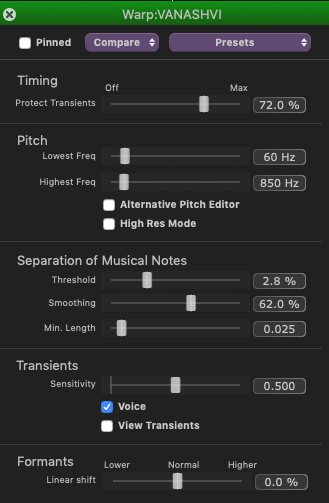Adjusting Warp settings
To adjust the Warp Region settings, open the relevant Process Control Panel.
 To do this, first make sure the correct Warp Output, or the Warp Input Process Control Block is selected (green), and the Session window is active.
To do this, first make sure the correct Warp Output, or the Warp Input Process Control Block is selected (green), and the Session window is active.
Then press the P key on the keyboard (or the "open" arrow in Warp Process Control Blocks) to open the Control Panel as shown right. Make any required adjustments and then press P again (or the close button) to close the panel.
You can repeatedly try modifying the parameters in the Control Panel and listening to the result. The control panel can remain open, the controls adjusted and processing run while signals are playing.
Presets allow you to use Factory or previously saved settings, and to save your own settings.
There is a Compare function to compare saved versions of a Process, and a Pinning control to keep this Process Control Panel open.
The Warp Control Panel
Each of the controls shown has a "pop-up" explanation which will appear shortly after hovering the mouse pointer over a slider control or parameter display box, so the controls won't be described in detail in this User Guide.
Most of the settings in the top area of this control panel (shown right) have been described in Adjusting APT settings.
Separation of Musical Notes contains the following controls, which do not normally require modification.
- Threshold - The change in pitch needed to restart a new note boundary.
- Smoothing - The factor applied to create smooth pitch contours.
- Min. Length - For pitch values to be made into a note, they must be within the pitch threshold for this minimum length of time.
Transients contains the following controls:
- Sensitivity - sets the tightness of the detected transients (rapid onsets) in the audio
- Voice - sets the process specifically to handle voice signals
- View transients - displays faint purple vertical lines where transients (rapid onsets) have been detected in the audio
Formants
- Linear shift - adjusts the frequency of formant regions up or down to change the character of e.g. a voice. (Formants are resonant frequencies, typically of the vocal cavity, which affect the character of the sound. For example, female vocal formants have a slightly different structure to male ones.)
Basic main editing of the Output's time, pitch, level, etc. is described briefly next. Detailed editing following Warp processing is described in Manually adjust timing, pitch and level.